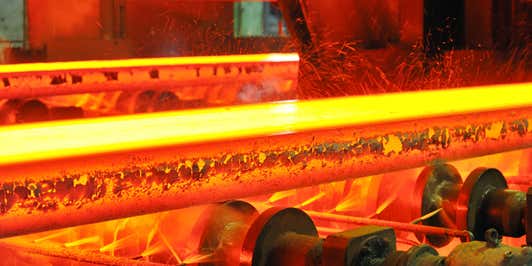

Analytical solutions for metal analysis and alloy manufacturing
We help you to meet demand, become more sustainable, and to make processes easier, cleaner and safer. With analysis that will help you find new possibilities . Our world-leading instruments, automated solutions, services and expertise will help you to set up your desired process control and quality control in the metal industry - whether it concerns primary metals or special products.
In the high-throughput, time-sensitive environments of the iron, steel, aluminum, copper, and titanium industries, process control and quality control are essential. As such, metals producers must be able to rapidly and accurately analyze the structure, particle size and shape, and density of their chemicals, metals, and alloys.
From bauxite to alumina and aluminum, rapid and precise monitoring of material streams is key in the aluminum analysis process. By monitoring process-relevant parameters, manufacturers can achieve their commercial targets and maintain process efficiency while also mastering the transition to CO2-free metal production. With Malvern Panalytical’s industrial solutions, you can analyze mineralogical (Aeris Metals) and elemental composition (Axios FAST, Metals edition of Zetium) and particle size and shape (Mastersizer 3000), as well as directly predict process parameters such as the available alumina in bauxite, the structural modifications of alumina, bath composition during aluminum smelting, and the impurities, stress, and texture of aluminum metal or alloys. Our solutions range from real-time analysis instruments (e.g., CNA cross belt analyzer, Epsilon Xflow, and Insitec) to fully automated laboratories.
Rapid, accurate monitoring of material streams is mandatory throughout the iron and steel-making process. Manufacturers must track process-relevant parameters to achieve their commercial targets and maintain process efficiency, while at the same time mastering the transition to CO2-free steel production. Malvern Panalytical’s industrial solutions enable you to analyze raw materials, as well as intermediate products such as iron sinter, iron ore pellets, and direct reduced iron (DRI), and final products like steel or steel alloys. Our solutions monitor mineralogical (Aeris Metals) and elemental composition (Axios FAST, Metals edition of Zetium), as well as particle size and shape (Mastersizer 3000). They can also directly predict process parameters such as the FeO content, the physical parameters of sinter and pellets, metallization and impurities, stress, and texture in steel and steel alloys. Our solutions range from instruments for real-time analysis (e.g., CNA cross-belt analyzer and Insitec) to fully automated laboratories.
As non-ferrous metals manufacturers work to achieve their commercial targets and transition to CO2-free metal production, fast and precise monitoring is critical in their production processes. From ores to copper, nickel, and zinc steel alloys, frequent monitoring of the various material streams is essential to ensuring maximum process efficiency. Malvern Panalytical’s industrial solutions enable you to analyze raw materials, intermediate products such as leachate or metal liquors, and final metal or metal alloy products. Our solutions monitor mineralogical (Aeris Metals) and elemental (Axios FAST, Metals edition of Zetium) composition, as well as particle size and shape (Mastersizer 3000). They can also directly predict process-relevant parameters such as the efficiency of solvent extraction and electrowinning, slag composition, and the stress and texture of metals and metal alloys. Our solutions range from real-time analysis instruments (e.g., CNA cross belt analyzer, Epsilon Xflow, and Insitec) to fully automated laboratories.
Manufacturers of metal coatings rely on frequent monitoring during the production process to achieve their quality and commercial targets while maximizing process efficiency. As the industry transitions toward CO2-free metals production, this analysis is only becoming more crucial. During the various coating processes such as galvanizing or galvannealing, rapid and precise monitoring to ensure quality and process efficiency are mandatory. Malvern Panalytical’s industrial solutions enable process optimization through efficient analysis, ensuring that quality specifications are met. Our instruments monitor the mineralogical and elemental composition of metal coatings, with solutions ranging from real-time analysis to fully automated laboratories.
Consistently producing metal components or products with the correct properties requires input materials with reliable characteristics that you understand fully. For metal powders, these characteristics can include chemical, morphological, and microstructural properties that must be measured using the appropriate analysis techniques. Particle size and shape are key properties in most metal powder processes since they impact powder flow, powder packing, porosity, reactivity, and even health and safety. Chemistry is also paramount, especially for powder metallurgy and additive manufacturing, in which powder needs to comply with the alloy composition of the material specified. The crystallographic structure can affect the mechanical and chemical properties of metal powders and fabricated components alike.
Our key solutions for particle characterization are the Mastersizer and Morphologi 4, which are highly automatable benchtop instruments. For metal nanoparticles and dispersions, our Zetasizer range offers a more appropriate solution.
Our floor-standing (Zetium) and compact (Epsilon) X-ray fluorescence spectrometers both provide elemental analysis, depending on application requirements. For structural and crystallographic studies, X-ray diffraction (XRD) is our principal solution and is also available in both floor-standing ( Empyrean) and compact (Aeris) system formats.
Analysis is mandatory at almost every stage of metals production. It provides essential information for quality assurance, enables efficient processes, and helps manufacturers achieve their targets in both profitability and sustainability. But to do this, choosing the right instruments is key.
For process control applications, an instrument with a high throughput capacity will be the best choice – such as a CNA cross-belt analyzer. But for quality assurance, where precision and accuracy are paramount, an automated laboratory solution will be more appropriate. By considering all the factors in an individual application, Malvern Panalytical’s in-house experts offer personal advice and guidance on the best choice for any need.
Malvern Panalytical’s innovative analytical tools and software, process integration and expert support provide a unique range of metals analysis solutions. From grading ores to preventing environmental contamination, our instruments optimize your processes, unlock sustainability, and drive profitability.

Metals manufacturing relies on excellent analysis, and understanding the mineralogical and structural properties of materials is essential to high-quality results. In high-throughput industrial processes such as iron production, efficiency is key – but structural analysis has historically relied on wet chemical and physical methods. These can be time- and labor-intensive, and are not well-suited to a busy industrial setting.
X-ray diffraction (XRD)
analysis overcomes this challenge by providing direct prediction of process parameters at a much higher throughput rate than older techniques, with the possibility of automation improving efficiency even further. In combination with elemental analysis, XRD provides additional insights into material streams – enabling more robust process control and bringing more sustainable production within reach.
An example of how XRD can contribute to a greener metals industry is its application in the characterization of direct reduced iron (DRI), which will play a key role in the steel production of the future. It also offers an efficient solution for monitoring electrolytic baths during aluminum production. Laboratory X-ray diffractometers, such as our Empyrean range, are often used to analyze retained austenite, stress and texture during steel production.
Trace elements can alter the final properties of metals in unpredictable ways. If trace elements are not monitored and controlled, they can cause defects in the finished product that may have serious consequences if the metal part fails or performs unreliably. For this reason, metals manufacturers need to closely monitor the trace element content in their metals. As customers require ever higher performance, steelmakers have had to improve their melting operations to control many chemical elements at levels of 50 ppm or below. The best method for monitoring elemental composition with this level of accuracy is X-ray fluorescence (XRF) analysis.
Control of trace substances has led to improvements in mechanical characteristics at various temperatures, toughness and fracture mechanics at low temperatures, weldability, hot and cold formability, and corrosion resistance. All these are essential performance parameters – so it’s clear that XRF adds real value to almost any metal production process.
At Malvern Panalytical, we are proud of our decades of experience in providing XRF analytical instruments to the metals industry – and proud to be helping so many of our customers manage the transition to a more sustainable and automated future in metals.
The innovative sensor design of our instruments and our tailored solutions add value across the evolving industry, and our expert application specialists are always available to support and assist our customers.
The drive toward automated metals production gets stronger each day – enabling researchers, manufacturers, and metal ore mine workers to operate more independently, efficiently, and safely. This is because automated processes allow much more frequent monitoring, including in remote environments. At Malvern Panalytical, we enable metals manufacturers to move toward automated operations with our automated lab testing solutions.
Watch our video to see the advantages of an automated lab:
As regulatory, competitive, and cost pressures increase, efficiency is more essential than ever for metals producers. By enabling quick, accurate control of critical parameters, real-time monitoring of raw materials and process streams can help save time, reduce waste, and ensure compliance with the tightest product specifications.
Our on-line solutions – including analyzers for liquids and cross-belt analyzers for blast furnace input – facilitate this real-time monitoring.
